Meetings
Overview
Sugar's Meetings module is used to track meetings, which can then be related to other Sugar records that may represent the attendees or topic of discussion. You can schedule upcoming meetings to remind you when the scheduled time approaches, or you can log meetings you have already held to keep a record of the discussion. Meeting records can have multiple attendees, both inside and outside Sugar, and include the ability to send invitations as well as reminder emails. When a meeting is repeated on a regular schedule, you can configure it to recur.
Sugar's Calendar module displays your meetings and allows you to create meetings directly from your calendar. Meetings can also be viewed and created via the Timeline dashlet or Planned Activities dashlet on a contact or other related module record. For example, a contact record's Timeline dashlet displays Sugar meeting records that are related to the contact. Creating a meeting from the dashlets creates a relationship between the records automatically. For more information, please refer to the Sugar Dashlets documentation.
This documentation will cover using the Meetings module. For general usage instructions concerning views and actions that are common across most Sugar modules such as creating, editing, and deleting records, please refer to the Working With Sugar Modules section of this page.
Please note that you will only be able to see meeting records as allowed by your team membership, user access type, and assigned roles. For more information on teams and roles, please refer to the Team Management and Role Management documentation in the Administration Guide.
Meeting Fields
The Meetings module contains fields that come standard with Sugar. For information on using and editing various field types, refer to the User Interface documentation. The following definitions are suggested meanings for the fields, but the fields can be leveraged differently to meet your organization's needs. Users with administrator or developer access can alter, add, or remove fields via Admin > Studio. For more information on configuring fields, please refer to the Studio documentation in the Administration Guide.
| Field | Description |
| Assigned To | The Sugar user assigned to the meeting. Note: The user in the "Assigned to" field cannot be removed from a meeting's guest list. |
| Comment Log | A shared log of messages, comments, or other text, including the name of the user that added the log entry and the date and time it was added. It is possible to tag other users and link to other Sugar records in Comment Log entries by inserting a clickable pill; see the User Interface documentation for more details. |
| Created By | The Sugar user who created the meeting. |
| Date Created | The date the meeting record was created. |
| Date Modified | The date the meeting record was last modified. |
| Date and Time | The date and time the meeting starts and ends. For recurring meetings, this is the start and end of the first meeting in the series. When in Edit mode, there are two components labeled "Start" and "End". |
| Display URL | The URL to access the meeting if hosted by an external application (e.g., WebEx, GoToMeeting, etc.). Note: This is a dependent field that appears when a value other than "Sugar" is selected as the meeting type. |
| Email Reminder Time | Send a reminder email to all meeting guests at a specified duration prior to the meeting's start time. |
| Guests | The attendees invited to this meeting. Note: When creating a new meeting, if the Guests field is low enough in the view to not be visible upon loading, the view is automatically scrolled down so that the Guests field is visible. As a result, it can be helpful to keep the Guests field within the first page of fields if there are a lot of fields to display; this ensures that the top of the view is displayed on initial load. |
| Integration Sync ID | The sync key field used by external integrations to identify Sugar records in the external application. See the Integrate REST API endpoints in the Developer Guide for more details on how to use this field. |
| Internal Notes | Notes about the meeting that are visible only to internal users. |
| Invitation Body | A description or other information about the meeting that is sent to meeting guests. |
| Location | The meeting location. |
| Meeting Password | The password to access the meeting via WebEx, GoToMeeting, etc. Note: This is a dependent field that appears when a value other than "Sugar" is selected as the meeting type. |
| Meeting Type | The application (e.g., Sugar, WebEx, GoToMeeting, etc.) hosting the meeting. Note: External meeting accounts (e.g., WebEx, GoToMeeting) are added to the Meeting Type field when users connect to their account via the External Accounts subpanel in their user preferences. For more information on connecting to external applications, please refer to the External Accounts subpanel section in the Getting Started documentation. |
| Modified By Name | The name of the Sugar user who last modified the meeting record. |
| Popup Reminder Time | Trigger a reminder popup alert to all Sugar user guests at a duration prior to the meeting's start time. Note: Users must be logged into Sugar in an open browser window in order to receive the popup reminder. |
| Related To | The related module record associated with the meeting. |
| Repeat Type | For a recurring series of meetings, the timespan unit (e.g., Every x days = "Daily", Every x weeks = "Weekly") to use for the interval of time between recurrences. |
| Repeat Interval |
Shown when Repeat Type does not equal "None", the interval between recurrences. Options are every 1 - 99 days, weeks, months, or years. For example:
|
| Repeat On |
Shown when Repeat Type is "Weekly", "Monthly", or "Yearly". The options depend on which Repeat Type is chosen.
|
| Repeat | Shown when Repeat Type does not equal "None"; Select "Until" to set a hard end date to recurrences or "Occurrences" to specify the number of times to repeat the meeting. |
| Repeat Until | Shown when "Repeat" equals "Until", the date of the last occurrence in the series. |
| Repeat Occurrences | Shown when "Repeat" equals "Occurrences", the number of meetings in the series. |
| Status | The current status (e.g., Scheduled, Held, Canceled, Deferred) of the meeting record. |
| Subject | The subject of the scheduled meeting. |
| Tags | User-created keywords that can be used to identify records in filters, dashlets, and reports. Note: For more information on creating and using tags, please refer to the Tags documentation. |
| Teams | The Sugar team(s) assigned to the meeting record. |
Meetings Color Codes
When viewing the Meetings list view and the Meetings dashlet, the start date may be highlighted in blue or red. This allows users to quickly view scheduled meetings that are either overdue or start within the next 24 hours. Please note that the start date will not be highlighted for meetings with a status of "Held" or with a start date in the future (beyond 24 hours from the current date and time).

The start dates in the Meetings list view are highlighted as follows:
- Blue: The meeting has not been held, and the start date occurs within the next 24 hours.
- Red: The meeting has not been held, and the start date has passed.
Please note that you can only see meeting records as allowed by your team membership, user access type, and assigned roles. For more information on teams and roles, please refer to the Team Management and Role Management documentation in the Administration Guide.
Meeting Guests
The following guests are automatically added to a meeting's guest list:
| Automatic Guest | To Remove the Guest |
| The lead or contact in the "Related to" field, if any | This guest can be removed from the guest list at any time. If a lead or contact record is related to a meeting but is not on the guest list, then you will not see the meeting in the person's Meetings subpanel. |
| The user who created the meeting | This guest can be removed from the guest list after initially saving the meeting. Create and save the meeting, click "Edit", and then click the Remove (-) button next to the created-by user's row in the Guests panel. |
| The user in the "Assigned to" field for the meeting record | The assigned user cannot be removed from the guest list. If you need to remove the assigned user from the guest list, you must first re-assign the meeting to a different user. Once the meeting record is assigned to a new user, the original user will remain a guest until removed via the Remove (-) button. |
Users may add additional guests (e.g., contacts, leads, users) to meetings via the Guests panel in the meeting's record view.
Adding via the Guests Panel
Use the following steps to add attendees via the Guests panel:
- Navigate to the Meetings module and create a new record or edit an existing record.
- Scroll to the Guests panel and click on the Add (+) button located on the far right.

- To add a guest, type in the name of the lead, contact, or user via the search bar that appears or select "Search for more..." to search the Contacts list view. To remove a guest, click the Remove (-) button to the right of the guest's row.
Note: The user in the "Assigned to" field on the meeting record cannot be removed from a meeting. To remove the assigned user from the guest list, re-assign the meeting to a different user first.
- Click "Save" or "Save and Send Invites" if you would like Sugar to send email invitations to the guests.
Note: Confirm that the guests' Sugar records have valid email addresses prior to clicking "Save and Send Invites". If a guest has no email address or their email address is marked as invalid, Sugar cannot email them an invitation to the meeting. A message and icon will alert you when adding the guest and when viewing the meeting's record view.
Once the guest has responded to the email invitation, their acceptance status will appear as a color-coded badge next to their name.
Adding via Create a Guest
Use the following steps to create a new contact and add them as a meeting guest:
- Navigate to the Meetings module and create a new record or edit an existing record.
- Scroll to the Guests panel, click on the Add (+) button, and then click on "Search for more..." to expand the Contacts list view.

- At the top of the list view, click the Create button and fill out the appropriate fields to create a new contact. Once completed, save the new contact record and Sugar will automatically add the contact to the guest list for the meeting.
- Confirm the remaining fields and guests are configured appropriately and then save the meeting.
Recurring Meetings
Meetings can be saved as recurring events so that users do not have to create individual meeting records for regularly occurring events. Recurrences may occur daily, weekly, monthly, or yearly. When a recurring meeting is saved, Sugar creates a series of individual meeting records so that all recurrences appear in the Meetings list view.
Note: If a user creates a recurring meeting but the start date does not match the specified recurrence day(s) of the week, the start date will reset to the first matching day after the meeting's Date Created.
Creating Recurring Meetings
To schedule a series of recurring meetings, follow the instructions below. As an example, we will schedule a 30-minute meeting that recurs every other Monday until the end of the 2024 calendar year.
- Navigate to the Meetings module and create a new record.
- In the Date and Time fields, use the Start field to enter the date and time that the first Monday meeting will occur and set the End field for the same day but 30 minutes later.

Note: If a recurring meeting's start date does not match the meeting's recurrence day(s) of the week, the start date will reset to the first matching day of week after the meeting's Date Created. - To create a series of meetings, open the Repeat Type field dropdown and select an interval from the dropdown list. Our use case requires an interval of weeks (e.g., every two weeks), so we will select "Weekly" and specify our interval number in the next step.

- Upon choosing a Repeat Type value, a new row of fields will appear on the form to gather the series information.

The fields displayed are dependent upon the values you select as you go. Please refer to the Meeting Fields section for complete details on the available options. To schedule a meeting that recurs every other Monday until the end of the 2024 calendar year, set the following values:- Repeat Interval: Every 2nd week
- Repeat on: Mon
- Repeat: Until
- Repeat Until: 12-31-2024
- Confirm that the remaining fields and guests are configured appropriately.
- Save the record and confirm that all recurrences appear as separate records in the Meetings module's list view.
Editing All Recurrences via Record View
Recurring activities will display the option to edit all occurrences of the activity in the record's actions menu. This option will affect all of the meeting records in a series, even if some of the meetings have been closed and set to "Held". Use the following steps to edit all recurrences in a series of meetings via the record view:
- Navigate to the record view of any meeting in the series of recurring meetings.
- Select "Edit All Recurrences" from the Actions menu.

- Edit the meeting record as needed.
- Then click on "Save" or "Save and Send Invites" to apply the changes to all held and unheld meetings in the series.

Deleting All Recurrences via Record View
Recurring activities will display the option to delete all occurrences of the activity in the record's actions menu. This option will affect all of the meeting records in a series, even if some of the meetings have been closed and set to "Held". Use the following steps to delete all recurrences in a series of meetings via the record view:
- Navigate to the record view of any meeting in the series of recurring meetings.
- Select "Delete All Recurrences" from the Actions menu.

- A pop-up message will display asking for confirmation. Click "Confirm" to delete all held and unheld meetings in the series.
Deleting All Recurrences via List View
Recurring activities will display the option to delete all occurrences of the activity in the record's actions menu in the list view. This option will affect all of the meeting records in a series, even if some of the meetings have been closed and set to "Held". Use the following steps to delete all recurrences in a series of meetings via the list view:
- Navigate to the Meetings list view by clicking the Meetings module tab.
- Use the Module Search to find the meeting in the series of recurring meetings that you wish to delete.
- Click the Record Actions Menu to the far right of the record's row and select "Delete All Recurrences".
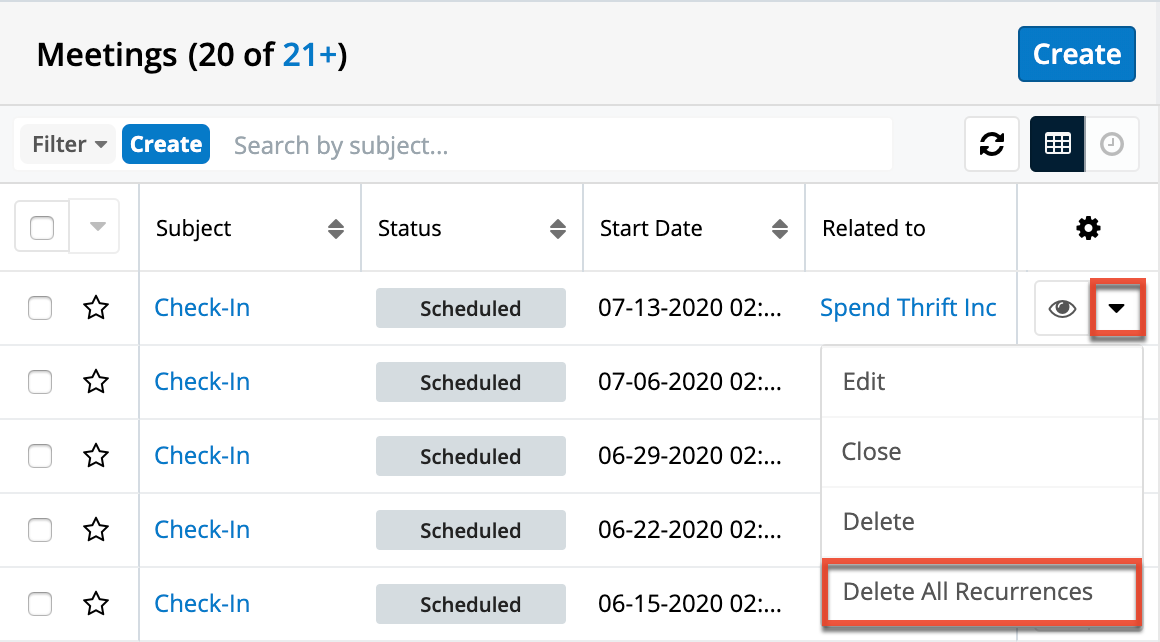
- A pop-up message will display asking for confirmation. Click "Confirm" to delete all held and unheld meetings in the series.
Meeting Reminders
Sugar can remind guests when a meeting is scheduled to begin soon. Reminders can be sent via email to all of the guests or via pop-up to all user guests prior to the meeting's scheduled start date and time. By default, a user must set reminders when creating or editing the activity, but users can configure default reminders via their User Preferences, which will automatically set a default reminder time for meetings they create in Sugar.
Note: The instance's outbound mail server must be configured via Admin > System Email Settings in order for email reminders to be sent out. For more information on setting up the system email settings, please refer to the Email documentation in the Administration Guide.
Email Reminders
Email reminders can be set for any meeting record relative to its start date and time. The reminders are emailed to all guests with valid email addresses including non-Sugar users.
To schedule email reminders, select a time interval from the meeting's Email Reminder Time field: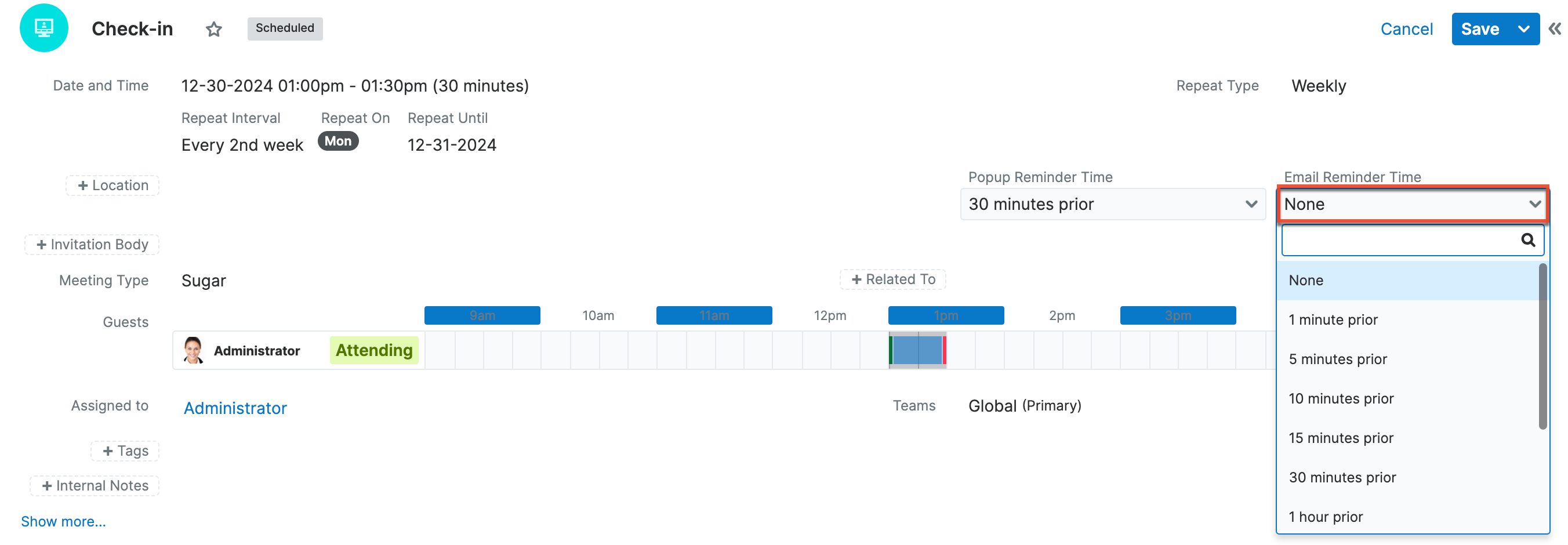
Popup Reminders
Popup reminders can be set for any meeting record relative to its start date and time. Popup reminders appear for Sugar users on the meeting's guest list who are logged into Sugar in an open browser window at the time the reminder pops up. To schedule popup reminders, select a time interval from the meeting's Popup Reminder Time field. Please note, meetings created with a start time of less than five minutes in the future will not trigger a popup reminder.
Closing Meetings
Once a meeting has taken place, a user can close the meeting record, which changes the meeting's status to "Held". The "Close" option only appears for meetings that are considered open, or not "Held". Open meetings are shown in the Planned Activities dashlet on the record view of related records and guests (e.g., Contacts, Leads, etc.). After closing a meeting, Sugar will move it from the Planned Activities dashlet to the History dashlet and the meeting record's status will display "Held" wherever it is viewed.
Closing via Record View
An open meeting's record view allows you to simply close the current meeting record or use "Close and Create New" to close the meeting and create a new meeting with the same details simultaneously. "Close and Create New" is often used when a user wants to log a completed meeting and easily schedule a follow-up meeting with the same people about the same topic.
To close a meeting record via its record view, click on the meeting to open its record view. Expand the record's Actions menu and select "Close" or "Close and Create New".
Depending on your selection, you will experience different results:
- Close: Instantly changes the meeting's status to "Held" and displays a Success message.
- Close and Create New: Instantly changes the meeting's status to "Held", displays a Success message, and opens a quick-create drawer for a new meeting record with the same values, guests, relationships. and other field values as the held meeting. The only field that is not copied from the original record is the status field, which will revert to "Scheduled" for the new meeting. Simply adjust the dates, times, and other information as needed, and save the new meeting as usual.
Once a meeting is closed, the closing options will no longer appear in the Actions menu.
Closing via List View
Use the following steps to close a meeting record via the list view:
- Click the Meetings tab to navigate to the Meetings module's list view.
- Use the Module Search to find the Meeting record(s) you wish to close.
- Click the Record Actions Menu to the far right of the record's row and select "Close".

Sugar instantly changes the meeting's status to "Held" and displays a Success message.
Closing via Dashlet
The Planned Activities dashlet is available for home page dashboards and on the record view's intelligence pane for Sidecar modules. From the home page dashboard, the Planned Activities dashlet displays all upcoming calls and meetings assigned to you or your team depending on your chosen filters. When viewing the Planned Activities dashlet from a record's intelligence pane, the calls and meetings shown are only those that are related to the record you are viewing. For example, when viewing the contact record for Joe Smith, the Planned Activities dashlet in the intelligence pane will show only the upcoming calls and meetings with Joe Smith on the guest list. For more information about the Planned Activities dashlet, please refer to the Sugar Dashlets documentation.
Use the following steps to close a meeting record via the Planned Activities dashlet:
- Navigate to your home page's dashboard or the record view that contains the Planned Activities dashlet showing the meeting you would like to close.
- If necessary, click the Meetings tab on the Planned Activities dashlet to find the meeting.
- Click the Held (x) button to the right of the meeting's row in the dashlet.
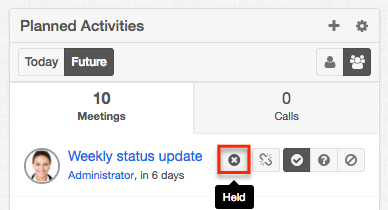
- A pop-up message will display asking for confirmation. Click "Confirm" to move the meeting to the record's History dashlet with the status "Held".
Working With Sugar Modules
While the Meetings module has some features that only apply to meetings, it also uses the Sidecar user interface that most Sugar modules are based on. The following sections detail menus, views, and actions common to Sidecar modules and contain links to additional information within the page or links to the User Interface documentation.
Meeting List View Filters
While universal list view filters are included with Sugar® out-of-the-box, the following filters are unique to the Meetings list view:
- My Meetings as Guest: All meetings for which you are a guest, either because you are a non-removable guest by virtue of being the assigned-to user or because you have been invited and not declined the invitation. All meeting status types are included in this filter (scheduled, held, canceled, deferred).
- My Meetings as Owner: All meetings for which you are the assigned-to user. All meeting status types are included in this filter (scheduled, held, canceled, deferred).
- Scheduled Meetings as Guest: All meetings with a "Scheduled" status for which you are a guest, either because you are a non-removable guest by virtue of being the assigned-to user or because you have been invited and not declined the invitation.
- Scheduled Meetings as Owner: All meetings with a "Scheduled" status for which you are the assigned-to user.
Meeting Menus
The Meetings module contains various options and functionality which are available via menus in the module tab, list view, and record view. The following sections present each menu and its options with links to more information about each option in the User Interface documentation or, for Meetings-specific functionality, within this page.
Module Tab Menus
Click the Meetings module tab in the navigation bar to access the list view. You may also click the three-dots menu in the Meetings module tab to display the Actions, Recently Viewed, and Favorites menus. The Actions menu allows you to perform certain actions within the module. The Recently Viewed menu displays the list of meetings you most recently viewed. The Favorites menu displays the list of meetings that you most recently marked as favorites. 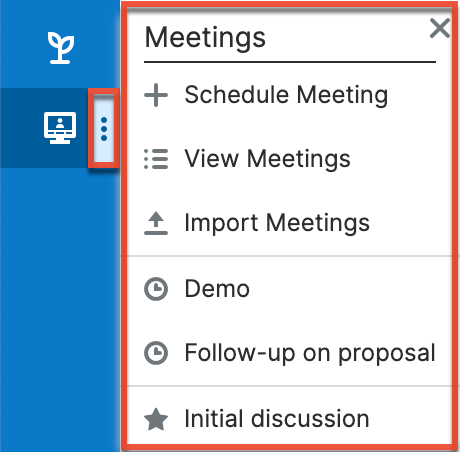
The Actions menu allows you to perform the following operations:
| Menu Item | Description |
| Opens the record view layout to create a new meeting. | |
| View Meetings | Opens the list view layout to search and display meetings. |
| Import Meetings | Opens the import wizard to create or update meetings using external data. |
For more information on module tab menus including reasons a module may not be included in the menu, see the User Interface documentation.
List View Menus
The Meetings list view displays all meeting records and allows for searching and filtering to locate specific meetings. You can see the basic details of each record within the field columns of the list view or click a meeting's name to open the record view. To access a module's list view, simply click the module's tab in the navigation bar.
List View Mass Actions Menu
The Mass Actions menu to the right of the checkbox option in the list header allows you to perform mass actions on all currently selected records. You can use the checkbox on each record's row to select individual meeting records or click the checkbox in the list header to select all records displayed on the current set of list view results.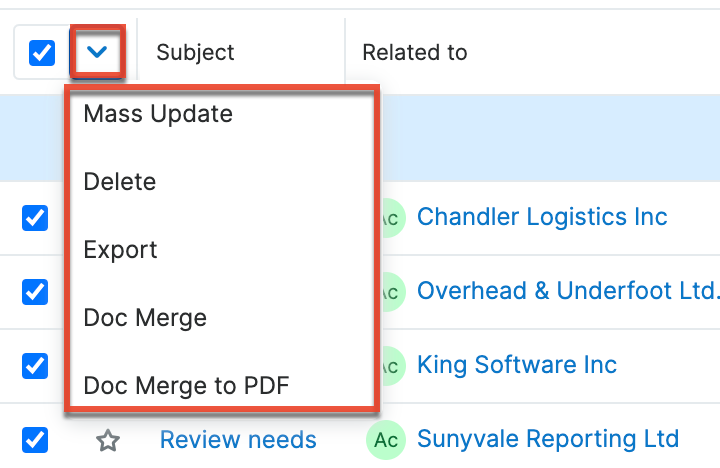
The Mass Actions menu allows you to perform the following operations:
| Menu Item | Description |
| Mass Update | Mass update one or more meetings at a time. |
| Recalculate Values | Visible only if the module contains fields using Sugar Logic and only to System Administrators or users with Developer-level role access, this option will refresh the selected records' calculated values. |
| Delete | Delete one or more meetings at a time. |
| Export | Export one or more meetings to a CSV file. |
| Doc Merge | Select or create a DOCX template to merge record data into documents that will be accessible in the Doc Merge widget. |
| Doc Merge to PDF | Select or create a DOCX, XLSX, or PPTX template to merge record data into PDF documents that will be accessible in the Doc Merge widget. |
| Map 1 | For instances with Sugar Maps enabled, display this record or the selected records on a map. |
| Directions starting from Current User 1 | For instances with Sugar Maps enabled, plot driving directions on a map from your address to this record or all selected records. |
1 The Meetings module must be enabled in Admin > Maps for the Sugar Maps option to appear.
List View Record Actions Menu
The Record Actions menu to the far right of each record's row allows you to perform actions on the individual meeting directly from the list view.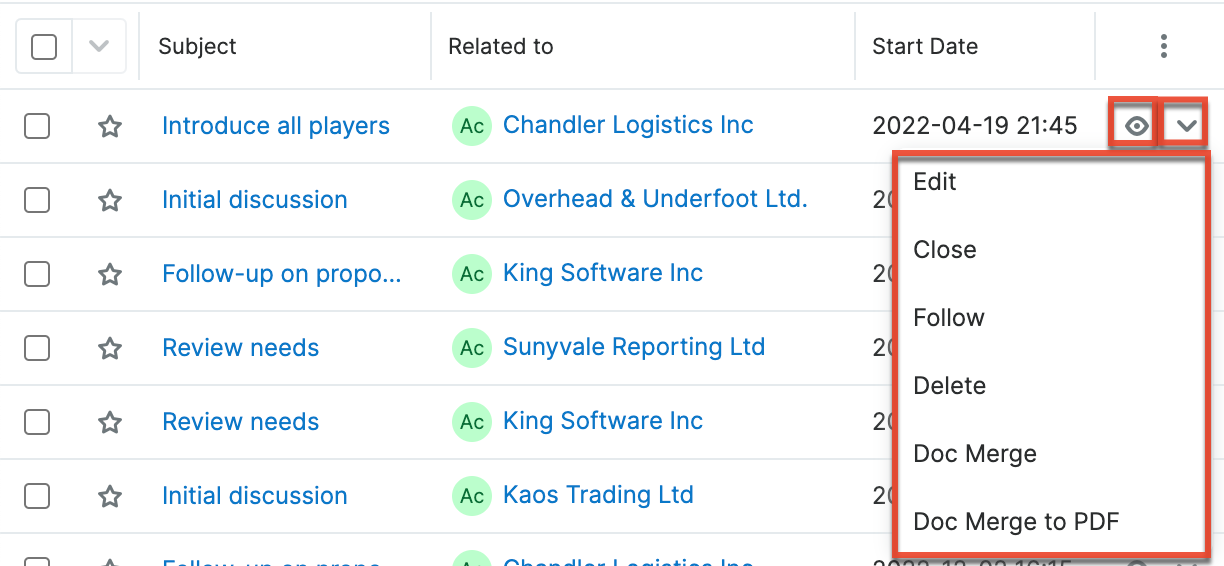
The list view's Record Actions menu allows you to perform the following operations:
| Menu Item | Description |
| Preview (Eye icon) | Preview this meeting in the intelligence pane. |
| Edit | Edit this meeting. |
| Close | Close this meeting. Note: Shown only for meetings that do not have a status of "Held". |
| Follow | (Available if Activity Streams are enabled) Follow changes to this meeting in your activity stream. |
| Directions starting from this record |
For instances with Sugar Maps enabled, plot driving directions on a map from this record to another record or records. |
| Delete | Delete this meeting. |
| Delete All Recurrences | Delete this meeting and all other meeting records in this meeting's series. Note: Shown only for meetings that are one in a recurring series. |
| Doc Merge | Select or create a DOCX, XLSX, or PPTX template to merge record data into documents that will be accessible in the Doc Merge widget. |
| Doc Merge to PDF | Select or create a DOCX, XLSX, or PPTX template to merge record data into PDF documents that will be accessible in the Doc Merge widget. |
Record View Actions Menu
The Meetings record view displays a single meeting in full detail including its fields, subpanels of related records, and activity stream. To access a meeting's record view, simply click a hyperlinked meeting name from anywhere within Sugar. The record view's Actions menu appears above the record's details and allows you to perform various operations on the current record.
The Actions menu allows you to perform the following operations:
| Menu Item | Description |
| Edit | Edit this meeting. |
| Edit All Recurrences | Edit this meeting and all other meeting records in this meeting's series. Note: Shown only for meetings that are one in a recurring series. |
| Share | Share a link to this meeting via email. |
| Download PDF |
Download the record's information as a PDF file.
|
| Email PDF |
Email the record's information as a PDF attachment.
Note: To send emails through Sugar, users must first configure a default user email account via Emails > Email Settings. |
| Copy | Duplicate this meeting to create a new meeting. |
| View Audit Log | View a record of changes to this meeting. |
| Delete | Delete this meeting. |
| Delete All Recurrences | Delete this meeting and all other meeting records in this meeting's series. Note: Shown only for meetings that are one of a recurring series. |
| Close this meeting as "Held" and create a new copy of the meeting. Note: Shown only for meetings that do not have a status of "Held". |
|
| Close | Close this meeting as "Held". Note: Shown only for meetings that do not have a status of "Held". |
| Doc Merge | Select or create a DOCX, XLSX, or PPTX template to merge record data into documents that will be accessible in the Doc Merge widget. |
| Doc Merge to PDF | Select or create a DOCX, XLSX, or PPTX template to merge record data into PDF documents that will be accessible in the Doc Merge widget. |
| Geocode 1 | For instances with Sugar Maps enabled, manually set this record's location on a map. |
| Map 1 | For instances with Sugar Maps enabled, display this record or the selected records on a map. |
| Directions starting from Current User 1 | For instances with Sugar Maps enabled, plot driving directions on a map from your address to this record or all selected records. |
1 The Meetings module must be enabled in Admin > Maps for the Sugar Maps option to appear.
Common Views and Actions
In the table below, the left column contains links to the User Interface page covering topics that are applicable to all Sidecar modules. The right column has links to sections of the current page that cover topics specific to meetings.
| General Instructions for Working With Sugar Modules | Meetings-Specific Instructions |
| Use the links below to navigate to the User Interface page which covers topics generic to many Sugar modules. | When Meetings-specific help exists for each topic, use the links below to navigate to sections of the current page. |
| Creating Records | Creating Recurring Meetings Meeting Guests Meeting Reminders |
| Viewing Records | |
| Searching for Records | |
| List View | List View Mass Actions Menu List View Record Actions Menu |
| Tile View | |
| Record View | Record View Actions Menu |
| Intelligence Pane | |
| Editing All Recurrences of a Meeting via Record View | |
| Deleting Records | Deleting All Recurrences of a Meeting via Record View Deleting All Recurrences of a Meeting via List View Closing Meetings |
| Exporting Records | |
| Favoriting Records | |
| Following Records | |
| Sharing Records | |
| Viewing Record Audit Logs | The Viewing Record Audit Logs section describes the View Audit Log record view option which displays a history of changes to the meeting's audited fields. |